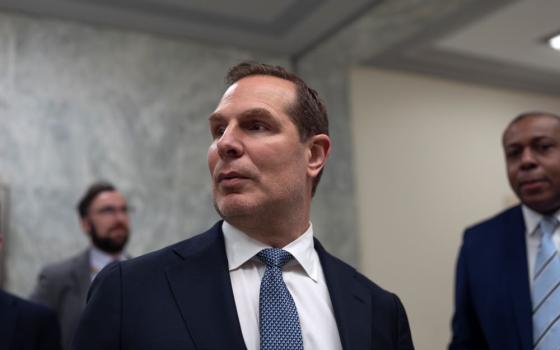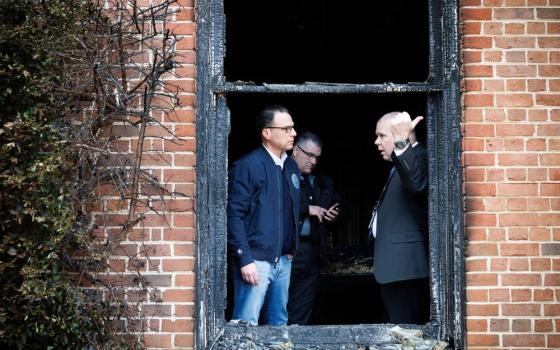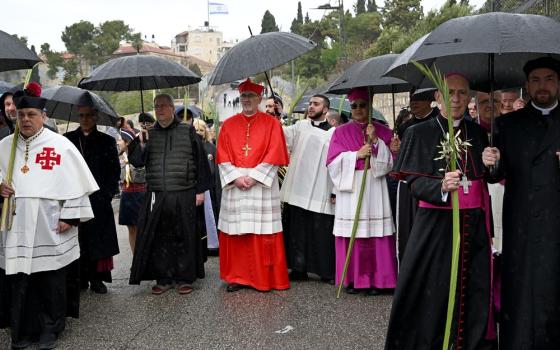On Saturday, I had the privilege of addressing a conference of deacons and their wives from Region One, a swath of the East Coast that includes portions of New York, Massachusetts, Connecticut, Vermont, New Hampshire, Maine and Rhode Island. This is to some extent ground zero for the sexual abuse crisis that has rocked the American Catholic church for the last five years.
Spending time with this group, I was struck anew by the resilience of the American church, even in those areas where the case for despair can seem the most persuasive. Despite a realistic grasp of the damage left in the wake of the crisis, there wasn’t much hand-wringing or “acid reflux” in this group. The energy was instead overwhelmingly positive, and conversation around the tables seemed focused on how to deliver the pastoral basics in more effective ways.
For example, I was interviewed for a “pod-cast” put together by a group called The Diaconal Ministry Team of the Diocese of Norwich, Connecticut, which takes as its motto “spirituality and justice to go!” The idea is to make the ancient tradition of Catholic spiritual wisdom, along with its thrust of social engagement, accessible in new media forms – thereby carrying forward the “preaching” dimension of the deacon’s task in a creative new way.
The pod-cast is available at www.thesignpodcast.com. My interview should be up in a few days.
The conference took place in Newport, Rhode Island, with a strong smell of the sea in the air. Perhaps the good humor of the conference reflected the beauty of the surroundings, because I suspect it would be hard to stay mad about anything for very long in such a tranquil environment.
I began by thanking the deacons and their wives for their countless sacrifices to keep the church alive. If the contributions of deacons are often unheralded, I said, those of their wives are all the more so, yet the church simply could not keep going without them.
I was asked to speak about current issues in the Vatican, and I covered three points:
•tChristian/Muslim relations
•tCatholic identity
•tThe crisis of secularism in the West
Each, I suggested, raises a vitally important challenge for the church. In each case, I argued, the central challenge of the moment is to find what Aquinas would have called the “just mean” between two extreme positions.
Here, for example, is more or less what I said on the subject of Catholic identity:
“It’s instructive to note that the term ‘Catholic identity’ does not appear in the documents of the Second Vatican Council. Such a concern would have seemed alien to many council Fathers, who presided over largely compact Catholic populations within which people memorized their catechisms, went to Mass and confession, took part in Corpus Christi processions, sent their sons and daughters to the seminary and the convent, and spoke the language of the Church without having to be reflective about it.
“The question that drove the council was not whether we were identifiably Catholic, but rather what else we were – that is, whether our markers of identity had atrophied into formal externals, in need of being placed in conversation with the great human questions of the day, and in so doing standing alongside other Christians, the followers of other religions, and all men and women of good will. At the time, a small minority inside and outside the council, a school of thought John XXIII once famously described as “prophets of doom,” warned that any compromise on Catholic distinctiveness would court seduction by secular modernism.
“More than forty years later, it has to be admitted that the supreme self-confidence which allowed the majority to brush aside such concerns was perhaps a bit naïve. Today, we have seen two generations of Catholics who are effectively un-catechized, a collapse in vocations to the priesthood and religious life, Mass attendance rates in some parts of Europe which dip into the single digits, and all the other familiar indicators of a Western ‘ecclesiastical winter.’ The bedrock of Catholic identity which the Fathers had assumed would keep the Church anchored while the winds of reform blew, as it turns out, was not quite as immutable as it seemed.
“At its best, today’s Catholic identity movement is therefore a quest to revitalize aspects of our traditional thought and practice which were too hastily or uncritically set aside, without rolling back the clock on the immense strides made in placing the Church in a critical dialogue with the modern world – in effect, a belated attempt to make sure that the baby is not tossed out with the bathwater.
“Yet we can also observe two more extreme reactions coursing through the Church which are, in a way, mirror images of one another. One is a sort of faux Catholicity, what George Weigel calls ‘Catholicism Lite,’ which tries to duck the identity question by redefining Catholicity as a sort of generic humanistic sentiment with a bit of religious window dressing, and a moral code that amounts to little more than ‘do good and avoid evil.’ The other is a defensive and polemic Catholic traditionalism that depends upon enemies, perceived or real, to give it strength. This reaction too fudges the identity question by attempting to define Catholicity in terms of the narrow borders of one or another Catholic tribe, which amounts to an artificial limitation of our universality.
“In the long run, what almost always prevails in the Church is what Aquinas called the ‘just mean’ between such extremes. Assuming this pattern holds, it suggests that the future will belong to those voices able to articulate a robust sense of Catholic distinctiveness, but one which does not shade off into a Taliban Catholicism that knows only how to excoriate, condemn, and smash the idols of ‘the other.’ What cannot be done, it seems to me, is to wish away the identity movement; that, I would submit, is a bit like trying to wish away winter.”
* * *
As a footnote to our discussion of Muslim-Christian relations, several deacons came up to me at various points in the day to mention the Hartford Seminary, a historically Protestant institution in Hartford, Connecticut, which has a strong ecumenical and inter-faith thrust. (Eight percent of the student body is Catholic).
The seminary has an impressive commitment to Christian-Muslim dialogue. One of its main academic centers is the Duncan Black Macdonald Center for the Study of Islam and Christian-Muslim Relations, the oldest center for Muslim studies in the United States. Hartford also recently received a gift of $2 million from Dr. Ali Bayram, a Turkish scholar and community representative, to fund a faculty chair titled “Professor of Contemporary Islamic Studies.”
Such initiatives suggest one way forward from the present post-Regensburg impasse between Christians and Muslims.
Beyond formal academic and inter-faith programs, however, there’s also a case for hope simply in the perennial human desire to make a difference. I recently lectured on Christian-Muslim relations at the University of Dallas, for example, and afterwards a young school-aged girl approached me to tell her story of making friends with a Muslim girl recently relocated to her small Texas community, who seemed isolated because she wears the hijab, or traditional Islamic dress for women. The Catholic girl reach out to the Muslim, and this year actually observed the month-long Ramadan fast with her as a means of showing support.
The Catholic girl hopes that her Muslim friend will go through Lent with her next year as a way of deepening their ties. On the strength of this experience, she is “pumped up” for the cause of dialogue.
In the absence of $2 million chairs, this sort of one-to-one outreach also carries tremendous promise. Despite the very real case for skepticism about the willingness of some parties to engage in meaningful dialogue, it suggests there’s a sort of common sense at the grassroots in all religious communities, and one hopes that with time it will prevail.




